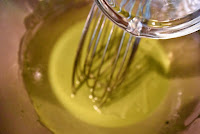This is fun to make. The batter you spread on the hot pan quickly produces air bubbles, which you gently rub or touch with paper or cloth to open up and make craters. Keep the heat level relatively high for the best bubbling results.
1 cake (1/5 of recipe):
110 calories; 3.2 g protein; 1.0 g fat; 21.5 g carbohydrate; 19.8 g net carbs; 23 mg sodium; 21 mg cholesterol; 1.7 g fiber
<Ingredients>
For fukusa crepe wrappers
50 g flour
1/2 tsp matcha green tea powder
20 g sugar
50 cc water
1 tsp mirin
1/2 (25 g) egg
0.3 g baking soda
0.7 g ammonium bicarbonate
2 tsp water (to dissolve baking soda and ammonium bicarbonate)
1/2 tsp oil (to cook fukusa wrapper; not in photo)
For filling
100 g tsubuan crumbly sweetened azuki bean paste
<Directions>
1.
Beat egg (use only 1/2 in this recipe).
In a prep bowl, put all ingredients other than leavening agents (baking soda, ammonium bicarbonate) and oil for crepe wrappers, and mix well.
The batter consistency is relatively thick but looser than pancake batter.
Cover, and let sit for 30+ minutes.
2.
In the meantime, prepare filling.
If tsubuan is too watery, heat in a pan or microwave with moistened paper towel on top (to prevent spattering), and remove excess moisture.
Divide tsubuan into five.
3.
When batter is ready, add 2 tsp water to baking soda and ammonium bicarbonate, and mix well.
Add mixture to batter, and mix well.
4.
Heat non-stick frying pan, put oil, and thinly coat surface using paper towel (almost wipe off oil).
5.
Mix batter well, and put approx. 1 tbsp + 1 tsp (to 1 1/2 tbsp) of batter, and quickly spread with back of spoon to approx. 10 cm/4".
Soon surface will be covered with bubbles.
Gently touch or rub tops of bubbles with paper or cloth to open them and make craters.
Flip, cook crater side for 4-5 seconds, remove, and cool on rack.
6.
When crepe wrappers are cool enough to touch, place each tsubuan portion on back (smooth) side, and wrap as desired.
One common way is to wrap in a rectangle.
Another common way is to wrap by gently squeezing wrapper around tsubuan.
Keep in covered container.
Best when served at room temperature.
<Notes>
- As with other sweets, variations in flavor or color for wrapper and filling are endless. When wrapper is made without matcha (photo at right), the taste of egg comes through, and the treat does indeed taste similar to dorayaki or taiyaki.
- Among green tea variations, when batter is made with cold water brewed gyokuro, the crepe wrapper becomes light tan color (photo at left). The wrapper has a faint tea taste, whereas matcha results in straightforward, strong tea taste.
- For both baking soda and ammonium bicarbonate, 1/4 tsp weighs approximately 1 g.
- This is traditionally made with ammonium bicarbonate (starts to bubble at lower temperature than baking soda). If not available, baking soda alone should be fine. When only baking soda is used, the crepe wrapper may taste somewhat bitter, and sodium content will increase by about 40 mg per cake.
- When the pan is not hot enough, bubbling does not actively occur. Uneven bubbling occurs when the batter is not mixed well immediately before pouring into the pan. (Both conditions are seen in photo at right.)
- Fukusa is a rectangular silk wrapper or pouch that often appears on ceremonial occasions to wrap (cash) gifts. Fukusa (silk or cotton) is also used to handle tea utensils at tea ceremonies. When used for food, fukusa typically implies something being wrapped.
- Chabukusa literally means tea fukusa, or fukusa used at tea ceremonies. But when it comes to the sweets above, the name seems to have taken on the image of a soft and fluffy ceremonial silk wrapper that gently covers a gift inside.
- For this cake, the crepe wrapper is sometimes simply folded in half (half-moon shape) with filling.



























5 comments:
Thanks for all the new recipes. I appreciate the in-depth notes and explanations with this one. When I first read the title 'Chabukusa' I wondered if it had anything to do with the familiar fukusa used when giving gifts or the cloths used in tea ceremonies or if it might just be a Japanese homophone!
I looks like this might require a bit of practise to achieve those perfect looking pieces. They really look like sea-sponges! regards, Philip
After writing the above, I realised that I still had some ammonium bicarbonate or rather a commercial raising agent with ammonium bicarbonate as it's main compound. I used slightly more as the packet had been open some time as well.
They turned out great, much better (looking) than expected for first try. I'm looking forward to have these with Japanese tea later. Thanks, Neco
Hope you enjoyed your chabukusa. I have been thinking about making some myself to take to my friends.
I made two batches and ate them all :) Might make more for the weekend - practise makes perfect, after all.
That's a good idea, your friends will be delighted.
Great to hear! Glad you liked them.
Post a Comment